Eavesdropping clues
Evidence of electronic eavesdropping or other spy activities can sometimes come from simple observation. When conducting electronic security sweeps, we always take note of anything that seems out of place. This awareness can help reveal trouble before it gets too far out of hand.
Even the best eavesdroppers may be nervous or have a lot on their minds. This could cause them to be careless when planting a bug or listening device. This would be true if they were spy-shop amateurs, disgruntled employees, or even state sponsored agents. Failure to clean up well after installing a device could leave the clue that gives them away.
Details on a failed surveillance operation from 2002 have recently emerged in a new book “Charlie One” by Sean Hartnett, a former covert British intelligence operative. They had planted listening devices in the home of Sinn Féin activist Raymond McCartney, but the operation got bungled when the spies accidentally left behind documents that contained notes and details of their surveillance of McCartney. When they realized they had forgotten the papers, it was too late to go back, they had to abandon the operation, knowing they would be exposed.
Pay attention to your surroundings
Clues may not be as obvious as papers detailing the spy efforts, but there are still a number of things you can pay attention to that might indicate that someone tried to breach your privacy.
If you normally keep your office locked (you should) but one morning you find either it unlocked, furniture in disarray, or something not as you had left it, this could be indication that someone had entered without authorization. Furniture legs will often leave marks or indentations in carpet or flooring. Looking at these marks could indicate if desks, tables, or furniture were moved.
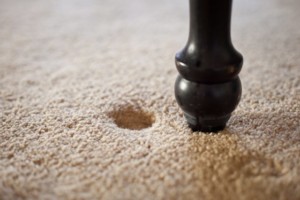
Carpet indentation could indicate that furniture was moved.
A cut or tear in the upholstery material of a chair or cushion might indicate someone attempted to insert a listening device, such as the bug recently found in a chair from the hotel room of the New Zealand rugby team, the All Blacks. A bulge under carpet or finding the edges of carpet pulled up could also be an indication of a covert installation of a microphone or wiring under the carpet.
Dust and debris
Finding particles or dust from a drop ceiling tile could indicate that someone had accessed the ceiling in your office or meeting room. Such dust can be hard to clean up completely. Also, many ceiling tiles are brittle and could easily lose chunks or pieces when moved or when re-seating them in place. If you notice any tiles have been disturbed, find out if any authorized maintenance was done recently, that could be the reason. If not, though, you may want to have more thorough inspection performed.
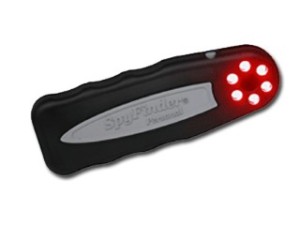
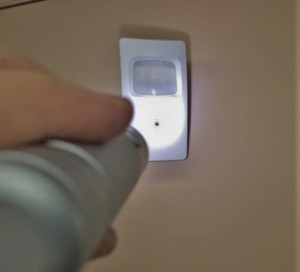
The “Spy-Finder” shows reflected light from a camera lens, but a flashlight can also be used in a similar fashion.
Holes in ceiling tiles could hide a camera
A small hole in a ceiling tile or other item could be the opening for a covert video camera. These photos show the hole of a video camera we found in a financial office. Checking the ceiling above revealed a hastily installed camera.

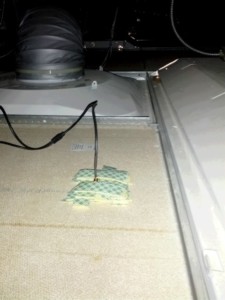
Air vents as a hiding place
Air vents are a common hiding place. Take a note of what your vents should normally look like. If there is any small object visible in the opening it could be suspicious. If you see something odd, one thing you can do right away is a comparison check in a different office that may have the same type of vent to see if they look similar. If not, you may want to investigate further.

An object is noticeable inside this vent. Compare it with vents in other offices to find out if it is normal.
Reflections could indicate hidden video
Camera lenses reflect light. A simple lens detector is a tool that can help to spot hidden cameras by flashing a light into a hole, creating a reflection from a lens if one was inside. Lens detector devices, often call “spy finders”, are available online for under a hundred dollars, but you can do a similar check by shining a flashlight into the hole. Hold the flashlight close to your eye, so you will be looking directly into the hole. If you see a reflection, it may be from a camera lens and you should investigate further.
Eavesdropping bugs disguised as common items
Have any new items appeared in your work area that you don’t remember seeing before? These could include wall chargers for cell phones, desk calculators, smoke detectors, or electric outlet strips that were not there previously. Many inexpensive spy devices are available that are disguised as outlet strips, wall chargers, and other such devices.
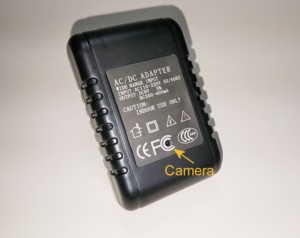

Camera hidden in a power supply and a cellular transmitter hidden in a desk calculator.
Outside contractors and cleaning crew
Do outside contractors have access to your office? Their purpose should be verified. You may want to request background checks for any companies who get regular admittance to confidential areas. If you have a cleaning crew with a set schedule, you should secure any areas that they should not have access to. Lock your file drawers, establish a “clean desk policy”, and practice it.
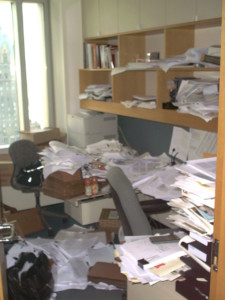
Keep your office clean and neat!
There could be legitimate reasons for any of the above incidents. An important step in evaluating your security is to understand as much as possible about the threats you face. Where do the threats come from and what financial value is at stake? A disgruntled employee with limited resources might try to use a simple device from a spy shop or online source. Employees might also have easy access to private areas. If your adversary is after highly valuable information, the threat could be more advanced. The damage from any eavesdropping would be severe, though, no matter how simple or advanced it is. You should consider having a professional TSCM security sweep done any time you feel your confidential information may be at risk.
Always be observant
Good advice for anyone concerned with security is to pay attention to your surroundings. This is especially true for information security and protecting communications. The evidence of a serious threat may be right in front of you.
